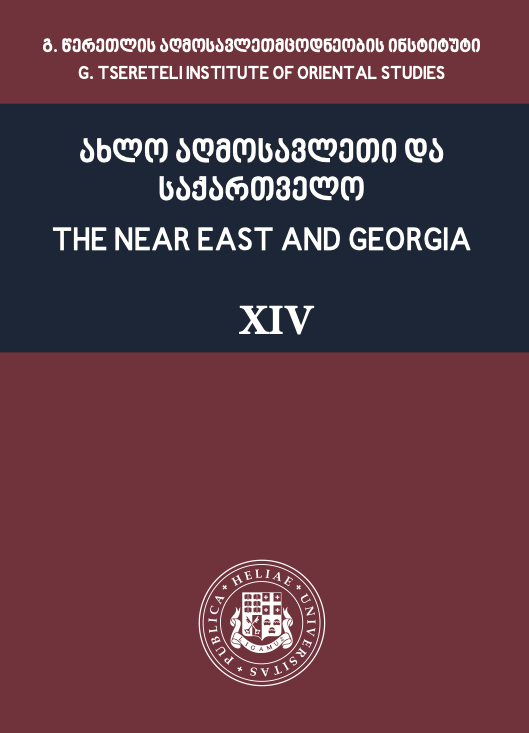IRANIAN "INSIGNIAS" OF THE CHILADZE SATAVADO ACCORDING TO THE 17TH-CENTURY ENGRAVED ICONS OF TKVIRI
DOI:
https://doi.org/10.32859/neg/14/408-421Keywords:
Chiladzes, Iranian influences, Tkviri, engraved icons, CtitorsAbstract
In the 1560s, the Chiladzes' Satavado participated in the battles between the central government and local principalities in Western Georgia. It is assumed that the origin of the Satavado dates back to the 15th century. They were vassals of Dadiani. The promotion and the decline of the Satavado were related to socio-political events and were constantly the subject of dispute between Dadiani, Gurieli, and the kings of Imereti.
The land of the Chiladzes was called Sajavakho, which was located between Guria and Samegrelo. Their domain was a convenient place for the kings of Imereti to fight and gain an advantage over the principalities of Odishi and Guria. Later, Gurieli and Dadiani divided this strategic territory among themselves - Gurieli occupied the southern part and Dadiani occupied the northern part. After that, this name was applied to the southern part of historical Sajavakho, and the northern part was called Sachilao.
The Chiladze family owned the village of Tkviri, where a family church was built at the turn of the 14th-15th centuries. The church walls were painted, but at the time of Ekvtime Takaishvili, it was already plastered and whitewashed. The wall paintings are not preserved. However, engraved icons of Tkviri remained on which the aforementioned family’s distinguished nobles of the 17th century are depicted.
From the 16th century, the increased number of Ctitors on the Georgian pieces of Art was due to the historical and social situation of the epoch. In the principalities, emerged smaller Satavados who owned lands, servants, fortresses and cathedrals which were the main attribute to the feudal ancestry. As a consequence of the division, some of them gained the ownership of the old ancestral churches, while others started building the new ones. In that period, new constructions were taking place in Georgia – building new churches, repainting the old cathedrals which is the characteristic of this era, considering that noblemen were adorning the walls of the churches, as well as chasing icons with their portraits in order to emphasize their power and sovereignty.
On the engraved icons of that period, changed the role of secular persons in the composition – if they were only the additions of the religious characters before, which was pointing to their subordinate position, the Masters of that period become free from the traditional approach and take more interest in Ktitors. Empowering the secular element – this is how the above-mentioned topic qualifies in the chasing art of that period.
- The engraved icon of Tkviri depicts Pepuna Chiladze with the posture of supplication, dressed in magnificent clothes. The inscription of Asomtavruli mentions the Ktitor’s contribution in chasing the icons and building the western egwter.
As it is seen from the inscription, Pepuna Chiladze was depicted on the icon after his death, by the order of his wife, Tamar Gurieli who then donated this icon to the Tkviri cathedral as the memorial of his spirit. The clothing of Pepuna indicates his social status in feudal society, alongside with the political orientation of the Satavado of Chiladze.
- On the wings of the icon of the savior in Tkviri, Rovanoz Chiladze and Utandar Chxetidze (husband and wife) are depicted with the posture of supplication. They are the parents of Levan II dadiani’s wife, Nestan-darejan.
- On the icon of the Mother of God in Tkviri, Varnozsi Chiladze is depicted with hands raised in supplication and is referred in the Asomtavruli inscription of the same icon with his son, Khosro.
Detailing clothes which is typical for wall painting, is restricted in chasing, because of its specifics. However, as mentioned by the researchers of this field, the way of dressing of that time is precisely illustrated on the chasing icons, because the goldsmith masters of that period show great interest in reality and real life while depicting secular persons. This reality was the Iranian trend in clothing which invaded the Georgian ordinary life. However, the works of chasing masters are free from the influence of Iranian art. They are following the national tradition and continuing the developing line of Georgian chasing art.
Becoming surrounded by Iran and Ottoman empire and especially the cultural expansion from Iran, left an important trace on the period of Georgian culture which is referred as late medieval centuries (14th-18th centuries). The political and cultural influence of Iran and country’s forced orientation towards the Eastern-Islamic world, led to implementing Persian habits in the lives of the high-class society.
The Iranian influence was much more evident in the eastern part of Georgia which was clearly reflected in the architecture. However, the things that were depicting the ordinary lives of high circles of aristocracy can be found specifically in the clothes of the nobles in western Georgia. As It is apparent from the observation, this can be explained by the political orientations of individual principalities and the heads of those principalities, as well as their relations in the specific historical period.




